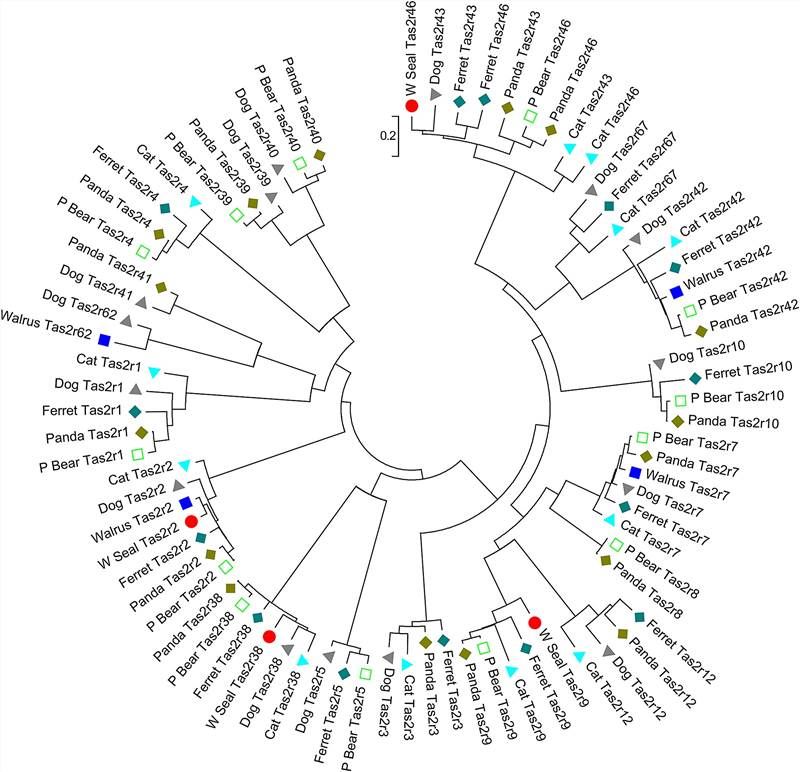Introduction of TAS2R1
TAS2R1 (Taste receptor type 2 member 1), a G protein-coupled receptor, is encoded by TAS2R1 gene. The protein can be expressed in the receptor cells of the tongue and palatal epithelium. It clusters in the genome and links to loci that influence pain perception in mice and humans. TAS2R1 can medicate bitter taste, which helps organisms avoid ingesting potentially toxic substances in food. Many studies conducted in TAS2R1 reveal that it is not only expressed in mucous epithelial cells of the tongue, but also in epithelial cells of the colon, stomach, and upper respiratory tract.
| Basic Information of TAS2R1 | |
| Protein Name | Taste receptor type 2 member 1 |
| Gene Name | TAS2R1 |
| Aliases | T2R1, TRB7 |
| Organism | Homo sapiens (Human) |
| UniProt ID | Q9NYW7 |
| Transmembrane Times | 7 |
| Length (aa) | 299 |
| Sequence |
MLESHLIIYFLLAVIQFLLGIFTNGIIVVVNGIDLIKHRKMAPLDLLLSCLAVSRIFLQL FIFYVNVIVIFFIEFIMCSANCAILLFINELELWLATWLGVFYCAKVASVRHPLFIWLKM RISKLVPWMILGSLLYVSMICVFHSKYAGFMVPYFLRKFFSQNATIQKEDTLAIQIFSFV AEFSVPLLIFLFAVLLLIFSLGRHTRQMRNTVAGSRVPGRGAPISALLSILSFLILYFSH CMIKVFLSSLKFHIRRFIFLFFILVIGIYPSGHSLILILGNPKLKQNAKKFLLHSKCCQ |
Function of TAS2R1 Membrane Protein
TAS2R1 is a member of the G-protein-coupled receptor superfamily, which is specifically expressed by the taste receptor cells of the tongue and palate. It encodes 7 transmembrane receptor proteins that act as a bitter receptor. Meanwhile, recent studies on the TAS2R1 receptor show that it mediates bitterness perception in mammals and evolves in response to species-specific diets. In addition, studies show that the high expression of TAS2R1 is found in upper respiratory epithelial cells. Furthermore, it is also expressed in bronchial smooth muscle cells where they stimulate the relaxation of airways for improved breathing. As recently shown, TAS2R1 can be expressed in cancer tissues, such as breast, lung, liver, and prostate cancer.
 Fig.1 Phylogenetic tree of Tas2r repertoires of seven species in the order Carnivora. (Lei, 2015)
Fig.1 Phylogenetic tree of Tas2r repertoires of seven species in the order Carnivora. (Lei, 2015)
Application of TAS2R1 Membrane Protein in Literature
This article analyses the ligand sensitivity of TAS2Rs in New World monkeys (NWMs) by heterogenous expression and calcium imaging in HEK293T cells. These results show there are differences among them, which provides a basis for understanding the differences in feeding ecology among NWMs with respect to bitter taste.
This article investigates the mRNA expression level of TAS2R1 and TAS2R38 in human skin, and they test if TAS2Rs in keratinocytes are functional. Results indicate TAS2Rs (TAS2R1 and TAS2R38) are expressed in the epidermis and might play a role in keratinocyte differentiation.
Authors select 195 TAS2R genes in 9 Carnivora species and examine selective pressures on these genes. These results suggest an adaptive response to a dietary shift from carnivory to herbivory and provide new insights into the molecular basis of mammalian sensory evolution.
TAS2R1 Preparation Options
To obtain the soluble and functional target protein, the versatile Magic™ membrane protein production platform in Creative Biolabs enables many flexible options, from which you can always find a better match for your particular project. Aided by our versatile Magic™ anti-membrane protein antibody discovery platform, we also provide customized anti-TAS2R1 antibody development services.
As a forward-looking research institute as well as a leading custom service provider in the field of membrane protein, Creative Biolabs has won good reputation among our worldwide customers for successfully accomplishing numerous challenging projects including generation of many functional membrane proteins. Please feel free to contact us for more information.
Reference
All listed services and products are For Research Use Only. Do Not use in any diagnostic or therapeutic applications.